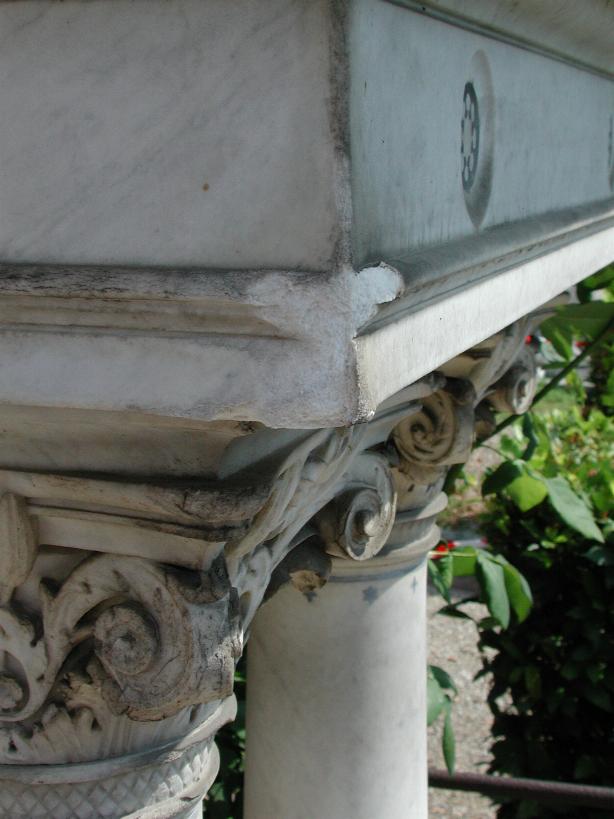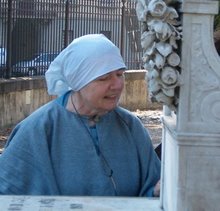I spoke at the Armstrong Browning Library, Waco, Texas, on her burial here in the 'English' Cemetery in Florence and about her now crumbling but very beautiful tomb designed by Lord Leighton. She was only fifty-five, having eloped from Wimpole Street from her Jamaican slave-owning father at forty to marry Robert Browning whose family came from a similar background from St Kitts. During those fifteen years of courtship and marriage, she wrote the Love Letters their son would later publish, the Sonnets from the Portuguese, 'The Runaway Slave at Pilgrim's Point', Casa Guidi Windows I and II, Aurora Leigh, the sonnet on Hiram Powers' Greek Slave, and Poems Before Congress, which Robert would publish. She had already, in Lady Geraldine's Courtship, prophesied that courtship before even meeting Robert Browning.
If you look carefully at the aerial map of the 'English' Cemetery you can see her tomb at its very centre. Those who visit it see also Florence's Duomo, at present shrouded in scaffolding.

There is something odd about the burial records and about the tomb. We know that Robert gave orders that she be dug up and re-interred in the more showy place from a letter he wrote to Isa Blagden and from the recorded double payment to the Cemetery's gravedigger. Though he never returned to Florence or to his wife's grave. The burial records mistakenly give her date as '45', not the true '55'. The tomb only gives her death date of 1861. She was older than Robert but kept this secret. Likewise, the tomb failed to give her name, only presenting her initials; it failed to give her portrait, substituting for it an idealized figure of Poetry; nor does it give anything of her poetry or of Robert's. Frederic Leighton's design was carried out by Luigi Giovannozzi who also participated in the tomb for the Duchess of Albany erected in Santa Croce. At the conference in Waco I showed that Leighton himself had wanted her portrait medallion on the tomb, and had originally designed it with framed spaces for inscriptions. He shaped it not as a classical sarcophagus but instead as like a medieval saint's tomb, on columns with space underneath for pilgrims to come for healing, as with Edward the Confessor's tomb in Westminster Abbey. He placed on three of its sides harps, one Greek with the masks of Tragedy and Comedy, one Hebrew with a broken slave shackle expressive of EBB's passionate hatred of slavery, and one Christian, with a cross.

Near her tomb are those of Hiram Powers, who sculpted 'The Greek Slave' and of Nadezhda, the Black Nubian slave brought to Florence, likely in the Champollion and Rosselini Expedition funded by Napoleon and the Grand Duke Leopold, her story told in Cyrillic on its base. Also here are the tombs of Theodore Parker and Richard Hildreth who preached and wrote passionately against slavery in America. While those of Isa Blagden and Theodosia Trollope are nearby, themselves past East Indian, part Jewish, and the models for Nathaniel Hawthorne's Miriam in the Marble Faun.
Sadly, during these celebrations her tomb itself has been forgotten and is being allowed to crumble away.

Here we see where acid has entered the marble turning it into plaster of paris so it is crumbling away. This process can be reversed if we can raise the funds speedily enough for this work. We failed initially to raise the 3000 euro necessary to restore it. A similar sum is being spent on a new bronze plaque to Elizabeth in St Marylebone Church, as is just, for previously there was only a plaque to Robert, not her. Similarly Casa Guidi has only a bust to Robert, not to Elizabeth, in its lobby. Even the Swiss-owned so-called 'English' Cemetery in which her tomb is placed, along with those of Walter Savage Landor, Arthur Hugh Clough, Isa Blagden, Fanny and Theodosia Trollope, Hiram Powers, Theodore Parker and many others, with tomb sculptures by Lord Leighton, William Holman Hunt, Félicie de Fauveau and others, a pantheon abroad of great English writers and artists, is at risk of closure, abandonment, and vandalism for lack of funds for its restoration. This is not likely to be the case with Robert's resting place, Westminster Abbey's Poet's Corner!
We also urge your signing the petition at http://www.thepetitionsite.com/takeaction/471134975,
to have the Cemetery remain open, to be restored and to be declared a UNESCO World Heritage Site
If you wish to donate to the Aureo Anello Association for the Elizabeth Barrett Browning tomb restoration you can do so by a cheque made out to 'Aureo Anello' and posted to 'English' Cemetery, Piazzale Donatello 38, 50132 Florence, Italy; or through the Pay Pal 'Donate' button below, which can also be used to purchase CDs, hand-bound limited edition books and sculptures of Elizabeth and Robert's 'Clasped Hands':




